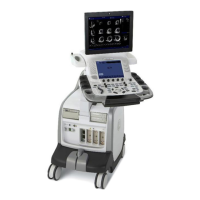GE H
EALTHCARE
D
IRECTION
GA091568, R
EVISION
5 VIVID E9 S
ERVICE
M
ANUAL
Chapter 8 - Replacement procedures 8 - 289
8-11-14 DVR Audio cable replacement
8-11-14-1 Preparations
When preparing for the replacement, you must perform the following steps:
1.) Power down the VIVID E9.
2.) Disconnect the Mains Power Cable from the wall outlet.
3.) Disconnect all probes.
4.) Remove the Left Side Cover.
5.) Remove the BEP Cover.
a.) Loosen the BEP Cover’s fixing screw(s).
- On BEP6 there are two finger screws on the top of the BEP Cover.
- On newer BEP5 there are three Phillips screws, one on the top and one on each side of
the BEP Cover.
- On older BEP5 there is one finger screw at the top of the BEP Cover.
b.) Tilt the top of the BEP Cover away from the BEP.
c.) Set the BEP Cover aside.
6.)
Related information:
• 4-2-2 "Power shut down" on page 4-8.
• 8-5-2 "Side Covers replacement" on page 8-38.
8-11-14-2 DVR Audio cable removal
1.) Disconnect one end of the DVR Audio cable from the connector on the DVR Board.
2.) Disconnect the other end of the DVR Audio cable from the connector on the motherboard.
8-11-14-3 DVR Audio cable installation
1.) Install one end of the DVR Audio cable to the connector on the motherboard.
2.) Install the other end of the DVR Audio cable to the connector on the DVR Board.
3.) Install the BEP Cover.
4.) Install the Left Side Cover.

